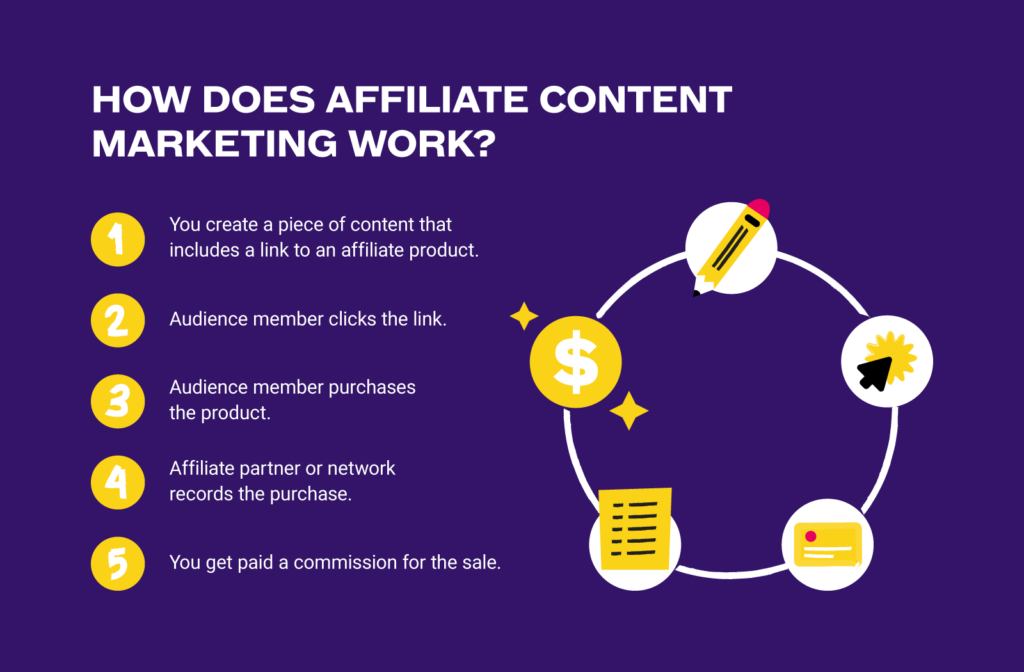Why is affiliate content marketing effective? Because consumers are more likely to purchase from brands that come highly recommended by people they trust.
Think of it like this: My friend has excellent taste in music. Whenever he texts me to suggest a new album or artist, I automatically search and hit download, confident that he’s sending me something great. Since I trust his opinion, I’m willing to try whatever he recommends.
That's how affiliate content marketing works in a nutshell.
Affiliate programs are a win-win for many reasons. Affiliate content marketing helps bloggers, influencers, podcasters, and other content creators open a profitable revenue stream while supporting the marketing efforts of brands seeking access to their target audience.
Curious to learn more? Let’s take a closer look.
What Is Affiliate Content Marketing?
Have you ever watched a YouTube video or listened to a podcast and heard the host mention a discount code for a product?
Maybe it’s something like:
“You can receive 15% off your next order from Anvil Corp using the code Affiliate15 at checkout.”
Or maybe you’ve read an article in which a blogger shares a link to a product they’re reviewing.
Both are examples of affiliate marketing. Essentially, affiliate marketing is a process in which publishers, influencers, or content creators earn a commission by promoting a brand, service, event, or product made by someone else using an affiliate link.
The advertiser (for example, a wellness brand) tasks the affiliate partner (for example, a blogger) with directing a target audience to take a specific action.
Most commonly, the desired action is to purchase a product, but it could also be to click on a link, sign up for a free trial, or generate a lead. The affiliate partner receives payment when they achieve the result the advertiser requested.

How Can Affiliate Content Marketing Help Your Media Company?
You’re already creating high-quality content for your audience. You’ve done the hard work of creating a niche, presenting yourself in an authentic and trustworthy manner, and developing a relationship with your readers, listeners, or viewers.
By doing so, you’ve created a container that brands will pay to have access to, a direct line to the consumers that could benefit from learning about their product.
In joining an affiliate program, you create a passive income stream that will earn money over the long term, with relatively little heavy lifting on your end. Additionally, partnering with reputable brands enhances your credibility by showing the world that your media company is a professional entity sought after for its advertising potential.
12 Popular Types of Affiliate Marketing Content You Can Create to Generate Revenue
There are several different types of affiliate marketing content. Let’s take a look at 12 of the most popular options:
1. Product reviews
Product reviews are an excellent way to showcase the benefits of the affiliate product you’re promoting. In-depth reviews provide your audience with valuable information that will help them make an informed decision at the point of purchase.
The best way to create a credible product review is to have first-hand experience using the affiliate product. That way, you’ll be able to share from your own perspective, adding authority and authenticity to the review.
2. Product comparisons
A side-by-side product comparison of a couple of brands (including your affiliate product) allows your audience to easily see the benefits of each and choose the one that’s right for them.
An in-depth product comparison includes features, pros and cons, pricing, customization options, information on customer service, and anything else your audience might consider valuable.
3. Product roundups
Similar to a product comparison, a product roundup features several products (including your affiliate product).
Rather than a side-by-side comparison, these content pieces provide an overview of each product’s features. Since they contain information about many different brands, product roundups can lead to improved search engine rankings and can easily be optimized for SEO.
While product roundups often take the shape of “10 Best” type pieces, they can also be a topical roundup based on the season (“Holiday Faves”) or tailored to a theme that resonates with your target audience (“Summer Picnic Accessories”).
4. Email marketing
Email marketing is among the heavy hitters of affiliate content marketing due to its remarkably high conversion rate (66%!). Your email list is a proprietary avenue that enables you to speak directly with your target audience.
Unlike social media, it’s a portal owned entirely by you. Nurture your newsletter subscribers by providing consistent value, and you’ll find that email marketing becomes a natural choice for promoting your affiliate products.
5. Resource pages
If you work with multiple affiliate partners, a resource page provides a central location to list them all in one place. This could be a thematic list (similar to a product roundup) or a landing page that lists all your “favorite products.”
The key to creating a useful resource page lies in the formatting. With so many products, vendors, and links, you want to ensure that it’s neatly organized to avoid confusing the reader.
6. Tutorials
Tutorials on your affiliate product add value for your target audience and give your affiliate partner a significant amount of time in front of your community.
While they’re a great idea for a YouTube video or webinar, bloggers can also create a step-by-step written tutorial in a blog post. If you choose this route, don’t miss the opportunity to optimize for SEO and use relevant hashtags so people can find your content.
7. Ebooks
Writing an ebook is an excellent way to create valuable content that elevates your status as a subject matter expert while showcasing your affiliate links. Pick a topic that interests you and brainstorm a list of products that could relate to your subject matter.
For example, if you’re writing an ebook on “Crochet for Beginners,” potential affiliate products might be crochet hooks and yarn.

8. Gift guides
Take a cue from Oprah’s book and compile a gift guide highlighting your affiliate partners. The holidays present a perfect opportunity to gather gift ideas and link them to affiliate products.
You could also create lists around the recipient of the gift and utilize this idea throughout the rest of the year (i.e., “Best Gifts for Teachers / Mom / Dad / Cat Lovers / etc.”).

9. Videos
TikTok videos, YouTube videos, and Instagram Reels are great options to show how you interact with an affiliate product. Though videos can be entirely based around the product (i.e., “My 5 Favorite Things About X”), you can also create a semi-unrelated video and devote a few minutes to an “ad” within (we see this a lot on YouTube).
Or, you can simply feature the product casually and then mention it directly in your caption (we see this a lot on social media). A coupon code is also commonly presented in a video as a bonus for audience members who click the link to the affiliate site.
10. Case studies
Case studies are another win/win because they allow you to show how your services have helped clients while highlighting an affiliate website.
Following the traditional case study format (Client, Challenge, Solution, Results), you can share how you add value for your clients and pepper in links to affiliate websites where those tools were relevant to the client’s success.
11. Buyer's guides
To create a buyer’s guide, you’ll want to begin with a solid understanding of audience motivation.
- What’s the problem they want this product to solve?
- What factors will influence their decision to buy?
From there, you can formulate a guide that positions your affiliate partner as the answer to these questions. Buyer’s guides make great blog content but can also translate well to video.
12. Social media posts
For influencers, content creation on social media is the bread and butter of any affiliate marketing campaign.
TikTok, Instagram, and Facebook present the opportunity to create viral content that amplifies the reach of your affiliate products while engaging with your audience and growing your community.
When you create a social media post, it’s worth looking at current trends (including trending sounds and formats) to see if any align with your affiliate product. It’s an excellent way to boost your reach and increase affiliate sales.
Need expert help selecting the right Unified Communications Software?
We’ve joined up with Crozdesk.com to give all our readers (yes, you!) access to Crozdesk’s software advisors. Just use the form below to share your needs, and they will contact you at no cost or commitment. You will then be matched and connected to a shortlist of vendors that best fit your company, and you can access exclusive software discounts!
Grow Your Media Company with Affiliate Content Marketing
If you’re an affiliate content marketing beginner, one way to test the waters is to join an affiliate network. These platforms act as a meeting place for content creators and brands seeking to advertise their products through affiliate marketing.
Rather than spending countless hours cold calling, joining an affiliate network can connect you with affiliate income quickly and efficiently by exposing you to multiple potential partners.
To learn more about some of the best affiliate networks out there today, check out this article by our subject matter experts:
- 10 Best Affiliate Networks for Indie Media Companies
- 10 Best Advertising Networks For Indie Media Creators
- Podcast: How To Build Niche Affiliate Websites
If you’re looking for ways to enhance your platform’s reach and build new revenue streams, don’t forget to subscribe to our newsletter to stay up-to-date on all the latest in your industry.



